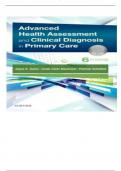lOMoARcPSD| 126
b b 567 13
, lOMoARcPSD| 126
b b 567 13
TEST BANK FOR ADVANCED HEALTH ASSESSMENT CLINICAL DIAGNOSIS IN
PRIMARY CARE 6TH EDITION DAINS |ALL CHAPTERS | A, GUIDE | BRAND NEW
Chapter b1: bClinical bReasoning, bDifferential bDiagnosis, bEvidence-Based bPractice, band bSymptom
AnalysisbMultiple bChoice
b
Identify bthe bchoice bthat bbest bcompletes bthe bstatement bor banswers bthe bquestion.
b 1. Which btype bof bclinical bdecision-making bis bmost breliable?
A. Intuitive
B. Analytical
C. Experiential
D. Augenblick
b 2. Which bof bthe bfollowing bis bfalse? bTo bobtain badequate bhistory, bhealth-care bproviders bmust bbe:
A. Methodical band bsystematic
B. Attentive bto bthe bpatient‘s bverbal band bnonverbal
blanguage
C. Able bto baccurately binterpret bthe bpatient‘s bresponses
D. Adept bat breading binto bthe bpatient‘s bstatements
b 3. Essential bparts bof ba bhealth bhistory binclude ball bof bthe bfollowing bexcept:
A. Chief bcomplaint
B. History bof bthe bpresent billness
C. Current bvital bsigns
D. All bof bthe babove bare bessential bhistory
bcomponents
b 4. Which bof bthe bfollowing bis bfalse? bWhile bperforming bthe bphysical bexamination, bthe bexaminer bmust bbe bable bto:
A. Differentiate bbetween bnormal band babnormal bfindings
B. Recall bknowledge bof ba brange bof bconditions band btheir bassociated bsigns band
bsymptoms
C. Recognize bhow bcertain bconditions baffect bthe bresponse bto bother bconditions
D. Foresee bunpredictable bfindings
b 5. The bfollowing bis bthe bleast breliable bsource bof binformation bfor bdiagnostic bstatistics:
A. Evidence-based binvestigations
B. Primary breports bof bresearch
C. Estimation bbased bon ba bprovider‘s
bexperience
D. Published bmeta-analyses
b 6. The bfollowing bcan bbe bused bto bassist bin bsound bclinical bdecision-making:
A. Algorithm bpublished bin ba bpeer-reviewed bjournal
barticle
B. Clinical bpractice bguidelines
C. Evidence-based bresearch
D. All bof bthe babove
b 7. If ba bdiagnostic bstudy bhas bhigh bsensitivity, b this bindicates ba:
A. High bpercentage bof bpersons bwith bthe bgiven bcondition bwill bhave ban babnormal
bresult
B. Low bpercentage bof bpersons bwith bthe bgiven bcondition bwill bhave ban babnormal
bresult
C. Low blikelihood bof bnormal bresult bin bpersons bwithout ba bgiven bcondition
D. None bof bthe babove
b 8. If ba bdiagnostic bstudy bhas bhigh bspecificity, b this bindicates ba:
A. Low bpercentage bof bhealthy bindividuals bwill bshow ba bnormal bresult
B. High bpercentage bof bhealthy bindividuals bwill bshow ba bnormal bresult
C. High bpercentage bof bindividuals bwith ba bdisorder bwill bshow ba bnormal bresult
D. Low bpercentage bof bindividuals bwith ba bdisorder bwill bshow ban babnormal
bresult
, lOMoARcPSD| 126
b b
b 9. A blikelihood b ratio babove b1 bindicates bthat ba bdiagnostic btest bshowing ba:
567 13
A. Positive bresult bis bstrongly bassociated bwith bthe bdisease
B. Negative bresult bis bstrongly bassociated bwith babsence bof bthe
bdisease
C. Positive bresult bis bweakly bassociated bwith bthe bdisease
D. Negative bresult bis bweakly bassociated bwith babsence bof bthe
bdisease
b 10. Which bof bthe bfollowing bclinical breasoning btools bis bdefined bas bevidence-based bresource bbased bon bmathematical bmodeling
to bexpress bthe blikelihood bof ba bcondition bin bselect bsituations, bsettings, band/or bpatients?
, lOMoARcPSD| 126
b b 567 13
A. Clinical bpractice bguideline
B. Clinical bdecision brule
C. Clinical balgorithm
Chapter b1: bClinical breasoning, bdifferential bdiagnosis, bevidence-based bpractice, band bsymptom bana
Answer bSection
MULTIPLE bCHOICE
1. ANS: B
Croskerry b(2009) bdescribes btwo bmajor btypes bof bclinical bdiagnostic bdecision-making: bintuitive band banalytical. bIntuitive
bdecision- bmaking b(similar bto bAugenblink bdecision-making) bis bbased bon bthe bexperience band bintuition bof bthe bclinician band
bis bless breliable band bpaired bwith bfairly bcommon berrors. bIn bcontrast, banalytical bdecision-making bis bbased bon bcareful
bconsideration band bhas bgreater breliability bwith brare berrors.
PTS: 1
2. ANS: D
To bobtain badequate bhistory, bproviders bmust bbe bwell borganized, battentive bto bthe bpatient‘s bverbal band bnonverbal blanguage,
band bablebto baccurately binterpret bthe bpatient‘s bresponses bto bquestions. bRather bthan breading binto bthe bpatient‘s bstatements,
bthey bclarify bany bareas bof buncertainty.
PTS: 1
3. ANS: C
Vital bsigns bare bpart bof bthe bphysical bexamination bportion bof bpatient bassessment, bnot bpart bof bthe bhealth bhistory.
PTS: 1
4. ANS: D
While bperforming bthe bphysical bexamination, bthe bexaminer bmust bbe bable bto bdifferentiate bbetween bnormal band babnormal
bfindings, brecall bknowledge bof ba brange bof bconditions, bincluding btheir bassociated bsigns band bsymptoms, brecognize bhow bcertain
bconditions baffectbthe bresponse bto bother bconditions, band bdistinguish bthe brelevance bof bvaried babnormal bfindings.
PTS: 1
5. ANS: C
Sources bfor bdiagnostic bstatistics binclude btextbooks, bprimary breports bof bresearch, band bpublished bmeta-analyses. bAnother
bsource bof bstatistics, bthe bone bthat bhas bbeen bmost bwidely bused band bavailable b for bapplication bto bthe breasoning bprocess, bis bthe
bestimation bbased bon ba bprovider‘s bexperience, balthough bthese bare brarely baccurate. bOver bthe bpast bdecade, bthe bavailability bof
bevidence bon bwhich bto bbase bclinical breasoning bis bimproving, b and bthere bis ban bincreasing bexpectation bthat bclinical breasoning bbe
bbased bon bscientific bevidence.
Evidence-based bstatistics bare balso bincreasingly bbeing bused bto bdevelop bresources bto bfacilitate bclinical bdecision-making.
PTS: 1
6. ANS: D
To bassist bin bclinical bdecision-making, ba bnumber bof bevidence-based bresources bhave bbeen bdeveloped bto bassist bthe bclinician.
bResources, bsuch bas balgorithms band bclinical bpractice bguidelines, bassist bin bclinical breasoning bwhen bproperly bapplied.
PTS: 1
7. ANS: A
The bsensitivity bof ba bdiagnostic bstudy bis bthe bpercentage bof bindividuals bwith bthe btarget bcondition bwho bshow ban babnormal, bor
bpositive,bresult. bA bhigh bsensitivity bindicates bthat ba bgreater bpercentage bof bpersons bwith bthe bgiven bcondition bwill bhave ban
babnormal bresult.
PTS: 1
8. ANS: B
The bspecificity bof ba bdiagnostic bstudy bis bthe bpercentage bof bnormal, bhealthy bindividuals bwho bhave ba bnormal bresult. bThe
bgreater bthebspecificity, bthe bgreater bthe bpercentage bof bindividuals bwho bwill bhave bnegative, bor bnormal, bresults bif bthey bdo
bnot bhave bthe btarget bcondition.
PTS: 1
9. ANS: A
The blikelihood bratio bis bthe bprobability bthat ba bpositive btest bresult bwill bbe bassociated bwith ba bperson bwho bhas bthe btarget
bcondition band babnegative bresult bwill bbe bassociated bwith ba bhealthy bperson. bA blikelihood bratio babove b1 bindicates bthat ba
bpositive bresult bis bassociated bwith bthe bdisease; ba blikelihood bratio bless bthan b1 bindicates bthat ba bnegative bresult bis bassociated bwith
ban babsence bof bthe bdisease.




